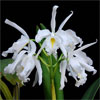|
|
|
|
|
| |
Flasks of
Cattleya maxima var. alba 'Kathleen' AM/AOS × self |
|
| |
|
|
| |
| Number: |
TN7274 |
| Name: |
Cattleya maxima var. alba 'Kathleen' AM/AOS × self
|
| Type: |
self (What's that?) |
|
Click to Enlarge

Pod Parent Flower |
Click to Enlarge

Pod Parent Inflorescence |
|
|
|
| |
Culture Notes from Donor: Parent plant: Temperature range Intermediate 83-60°F, cooler season Cool 70-52°F. Cattleya maxima, and this cultivar specifically, like a lot of light to bloom well. It also needs an open, quick-draining medium. It likes plenty of moisture and fertilizer during active growth and low moisture and feed when resting. Grows well mounted or potted in and quick-draining, open medium.
Comments: Parent plant: Bifoliate, with tall canes and broad leaves. Vigorous growth habit. Produces large heads of up to sixteen 5-inch white flowers with yellow in the inner lip. Very large plant.
For additional origin/habitat information supplied courtesy of
Charles and Margaret Baker, see further below, near the bottom of this page.
|
Temperatures we attempt to use in the lab & greenhouse:
| For Species: |
|
Spring, Summer, Autumn, Winter: days average 79°F, nights 53°F; best fit is Cool-Intermediate 75-58°F
(Source:
Baker's Web OSC) |
| For Genus: |
|
Spring, Summer, Autumn, Winter: days average 83°F, nights 60°F; best fit is Intermediate 83-60°F
(
) |
|
About the name...
| Etymology of |
alba |
|
From Latin "albus" white.
(Source:
Brown 1956) |
| Etymology of |
Cattleya |
|
Named in honor of William Cattley, English horticulturist in the 19th century.
(Source:
Pridgeon 1992) |
| Etymology of |
maxima |
|
From Latin "maximus" very large or grand.
(Source:
Mayr & Schmucker 1998) |
| Pronunciation of |
alba |
|
AL-ba
(Source:
Hawkes 1978) |
| Pronunciation of |
Cattleya |
|
KAT-lee-ya
(Sources:
Pridgeon 1992, Hawkes 1978) |
| Pronunciation of |
maxima |
|
MAX-i-ma
(Source:
Hawkes 1978) |
|
If you would like to direct someone to this web page, please copy and paste this URL into your email:
http://troymeyers.com/d?017274
| Flask Information |
| Availability: |
We have sold all of the flasks for this item. |
| You should: |
Consider getting individual plants or compots instead of a flask.
See if we have plants available in the greenhouse. |
| Yield Estimate: |
650 plants (based on flask surveys done 11/04/2013 through 11/07/2013)
|
| Plantlet Sizes: |
From many flasks 2 - 50 mm plants (based on flask surveys done 05/03/2012 through 06/09/2014)
From one most recently surveyed flask 20 - 50 mm (06/09/2014)
|
|
You might also want to:
|
View the seed assay for this item.
See if we have plants available in the greenhouse.
View items of the same species.
View items of the same genus.
|
| Ordering Information |
| You are not currently logged in. |
|
You must be a registered user and be logged in to reserve a flask or place a notification request. Please log in:
|
|
|
|
|
|
| |
The origin/habitat information below is supplied courtesy of Charles and Margaret Baker
The following information is based on the name of the plant provided by the donor, and assumes that the name is correct. If the plant has been misidentified, then the following information may not be correct.
This text is copyrighted by the Bakers and may not be reproduced without permission.
ORIGIN/HABITAT: Ecuador, Peru, and Colombia. This orchid was originally
discovered in the hot, humid lowlands around Guayaquil, Ecuador. Since
then, it has been found at high elevations on the western slopes of the
Andes in northern Peru, Ecuador, and southern Colombia. Because conditions
in the highland and lowland habitats are so different, we will treat them
as separate species with appropriate climate data for each.
Highland populations are found near El Oro and Loja in southern Ecuador
southward into Peru in the Departments of Cajamarca and Amazonas. Plants
grow in both dry and evergreen forests at 3300–6550 ft. (1000–2000 m).
Visitors to the northern Peru habitat report that most plants grew on long
tree branches at about 5900 ft. (1800 m).
The lowland population is found in southwestern Ecuador, where
temperatures are hot but rainfall is low and humidity is high. Plants grow
on horizontal branches of old trees in a desert or dry cloudforest. They
are usually found near sea level, but they are known to grow as high as
1950 ft. (0-600 m).
Upland variety
More about this information and the Bakers...
|
|
|
| |
|
|
|